




Bernd and Hilla Becher were German conceptual artists and photographers working as a collaborative duo. They are best known for their series of photographic images, (or typologies,) of industrial buildings and structures, often organised in grids. They influenced many documentary photographers and artists.
Bernd Becher was born in Siegen. He studied painting in Germany from 1953-1956, then typography (the art and technique of arranging type to make written language legible, readable, and appealing when displayed) from 1959-1961. Hilla Becher was born in Potsdam. After Hilla’s time studying photography at the Kunstakademie Düsseldorf from 1958-1961, she had completed an apprenticeship as a photographer in her place of birth. They both began working as freelance photographers (self-employed) for the Troost Advertising Agency in Düsseldorf, concentrating on product photography (advertising or commercial photography). The couple married in 1961. Bernd and Hilla Becher first collaborated on photographing and documenting the disappearing German industrial architecture in 1959. The Ruhr Valley, (where Becher’s family had worked in the steel and mining industries,) was their main focus. They were fascinated by the similar shapes in which the buildings were designed. After capturing thousands of pictures of individual structures, they noticed that the various large buildings, (of cooling towers, gas tanks and coal bunkers, for instance,) shared many distinctive formal qualities. In addition to this, they were intrigued by the fact that so many of these industrial buildings seemed to have been built with a great deal of attention towards its design. Together, the Bechers went out with a large 8 x 10-inch view camera and photographed these buildings from a straightforward “objective” point of view. They only did their shoots on overcast days, (to avoid shadows,) and early in the morning during spring and autumn. Objects included barns, water towers, coal tipples, cooling towers, grain elevators, coal bunkers, coke ovens, oil refineries, blast furnaces, gas tanks, storage silos, and warehouses.
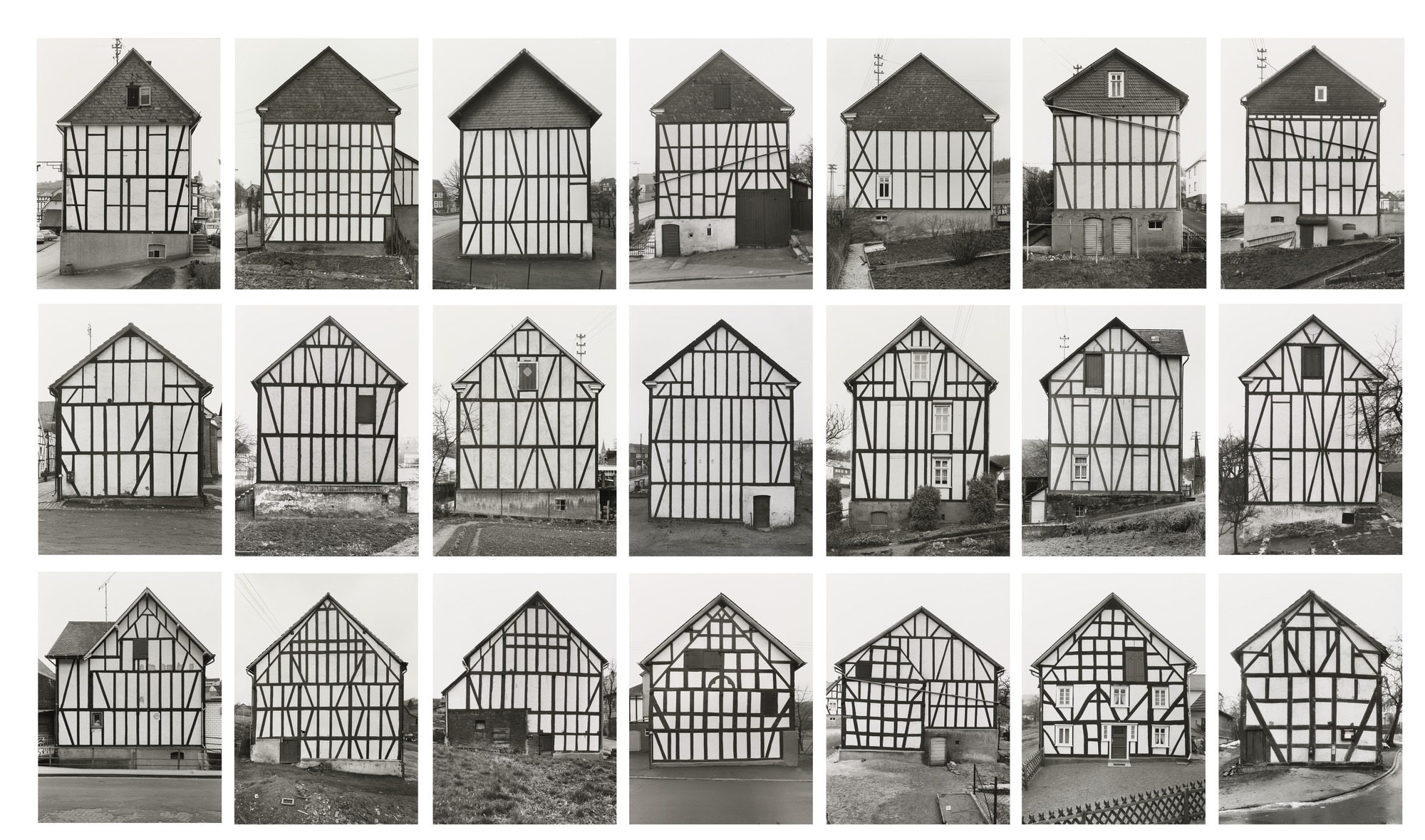
This typology created by the Becher’s shows their objectives of conceptual art. They wanted to create a series of images where every object showed similar characteristics. These images were taken in Germany, as their images were based around the German industrial architectures. Each image is similar to the other, because of the repeated lines of wood that are used as part of each houses construction. This repetition effect is something that intrigues me towards these series of images. I like how each house has a triangular rooftop – the houses are a classic shape and although they seem like original shaped houses, they all have their own speciality that differentiates them from each other. For example, on the bottom row, second image from the right, this house appears to have 5 rectangular windows with a variance in how the panels for the window are displayed. The white panels all determine how many small squares there are inside of the window – some windows have 6 small squares, some only have 2 squares and 2 long rectangles. This same house has 1 door that has 2 slight windows either side of the door. This house is very different to the houses around it on the grid format, that the Becher’s used to create their typology. However, they all have similar shapes and objects that create the houses.
Variations in the time of day, season or weather can instantly transform a familiar landscape, whether urban or rural. One heavy rain or low cloud formation reflecting the evening sun’s rays can make us aware of places we normally take for granted. Many artists have documented the same views again and again to demonstrate the beauty of such ephemeral events. Monet’s Haystacks and his studies of Rouen Cathedral demonstrate these effects with sensitivity and keen observation. Other artists inspired by these dramatic shifts are Camille Pissarro, Joan Eardley, John Virtue, David Tress and David Prentice.

David Tress (born 11 April 1955) is a British artist noted particularly for his deeply personal interpretations of landscapes in and around his home in Pembrokeshire, southwest Wales. He combines the techniques of collage and impasto with conventional painting and drawing to produce results that have been categorized as a form of abstract expressionism. Deciding that he had reached the limit of what he could achieve with realism alone, he instead developed an aggressively expressionist style that involves physically scraping or cutting the painted surface and then repairing it, building up layer upon layer as if to mimic the seasonal sequence of decay and regrowth. Tress makes sketches in the field but the final paintings are done in his studio, relying as much on memory and emotional response to the subject as on the original drawing. Although much of his work borders on the abstract, some, particularly his graphite drawings, is intensely realistic, taking on an almost photographic quality when viewed from a distance. As well as Wales, his subjects include landscapes in Scotland, the Lake District, Ireland and southern France, along with cityscapes of London.

Joan Kathleen Harding Eardley (18 May 1921 – 16 August 1963) was a British artist noted for her landscapes of the fishing village of Catterline and surroundings on the North-East coast of Scotland. Her artistic career had three distinct phases. The first was from 1940 when she enrolled at the Glasgow School of Art through to 1949 when she had a successful exhibition of paintings created while travelling in Italy. From 1950 to 1957, Eardley’s work focused on the city of Glasgow and in particular the slum area of Townhead. In the late 1950s, while still living in Glasgow, she spent much time in Catterline before moving there permanently in 1961. During the last years of her life, seascapes and landscapes painted in and around Catterline dominated her output.[
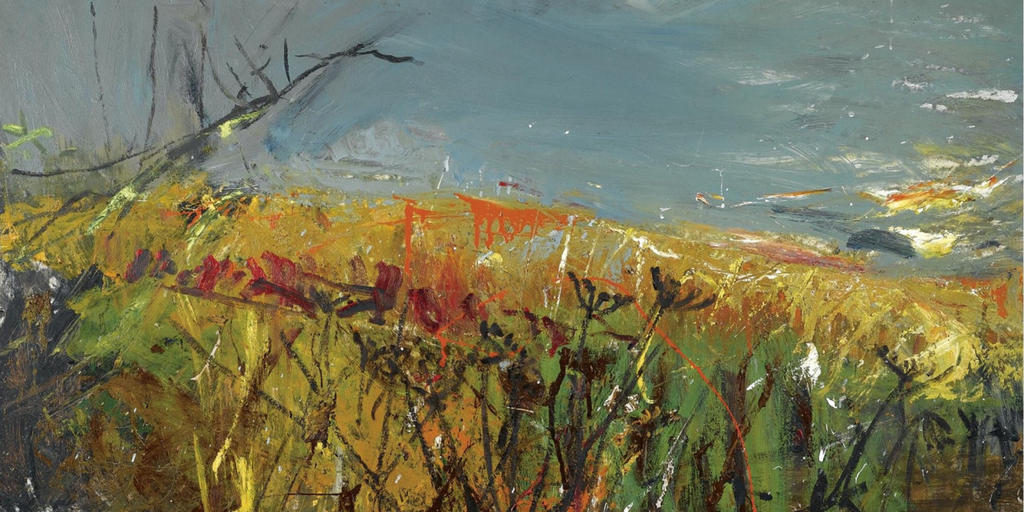
I have created a brainstorm linking the fine artist Jason de Graaf with Seydou Keita, based around portraiture and mirrored imagery. However, after brainstorming the links and ideas between the two, I have decided to go down the route of landscapes rather than portraiture for my project.
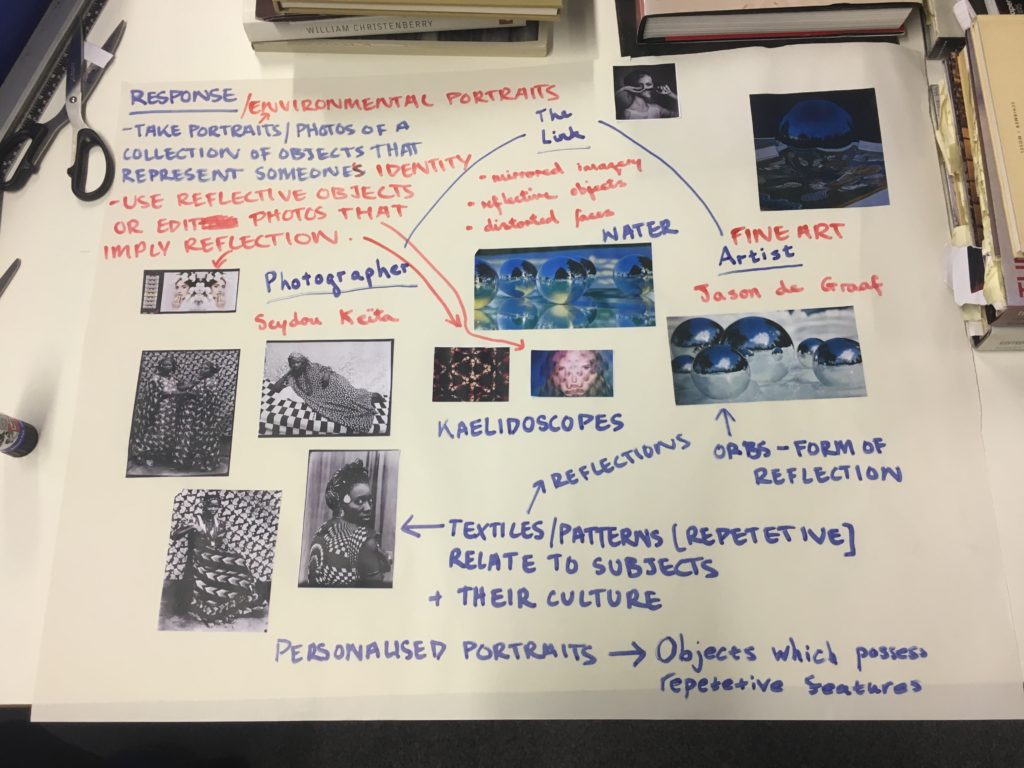

Michael Wolf, born 1954, is a German artist and photographer who resides in and works in Hong Kong and Paris. Wolf’s work focuses on the daily life within big cities such as Hong Kong. Wolf one first prize in the Contemporary Issues category of the 2004 World Press Photo competition for his photographs of workers in several types of factories. His career began in 1994 as a photojournalist, when he spent eight years working in Hong Kong for German magazine ‘Stern’. Wolf says that a decline in the magazine industry led to photojournalism assignments becoming “stupid and boring” therefore he decided to work on only fine-art photography projects from 2003.
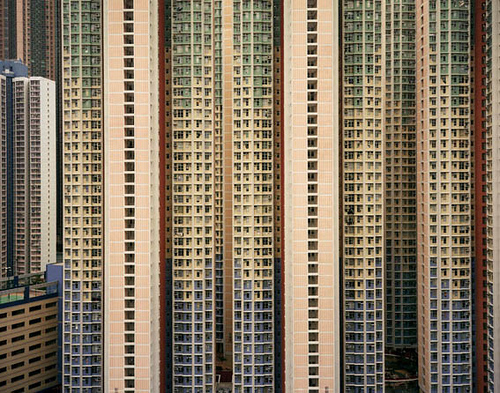
In Wolf’s series titled “Architecture of Density” he photographs Hong Kong’s tall buildings in order to show them as “abstractions, never-ending repetitions of architectural patterns” – the photographs excluded the sky and the ground and so emphasised the vertical lines and shapes within the buildings. The first book containing images from the series, Hong Kong: Front Door/ Back Door, was published in 2005 – in this book reviews noted how the photographs represented the overpopulation occurring in the city and the massiveness of the human presence.
I intend to take a lot of inspiration from Wolf’s work on ‘Architecture of Density’ as I believe that his work on this project brilliantly demonstrates the similarity within buildings through the patterns that are demonstrated within them as well as bringing light to how different the buildings all are, even though they all often contain very similar shapes and structures. I like Wolf’s work a lot due to the patterns and repetition within the photographs, I feel that they create a very intriguing and abstract appearance to the work as you are initially unsure at what you are looking at. Of course Wolf creates this work using much larger buildings and so can further dramatise these effects of massive repetitive buildings so in my responses to this work it will likely be necessary to use photoshop in order to create more repetition to achieve the same effect as Wolf has. Ultimately Wolf shows the repetition within the world we live in as well as showing the fact that even though there are so many buildings built for the same purpose, they all manage to have their own individualistic features.
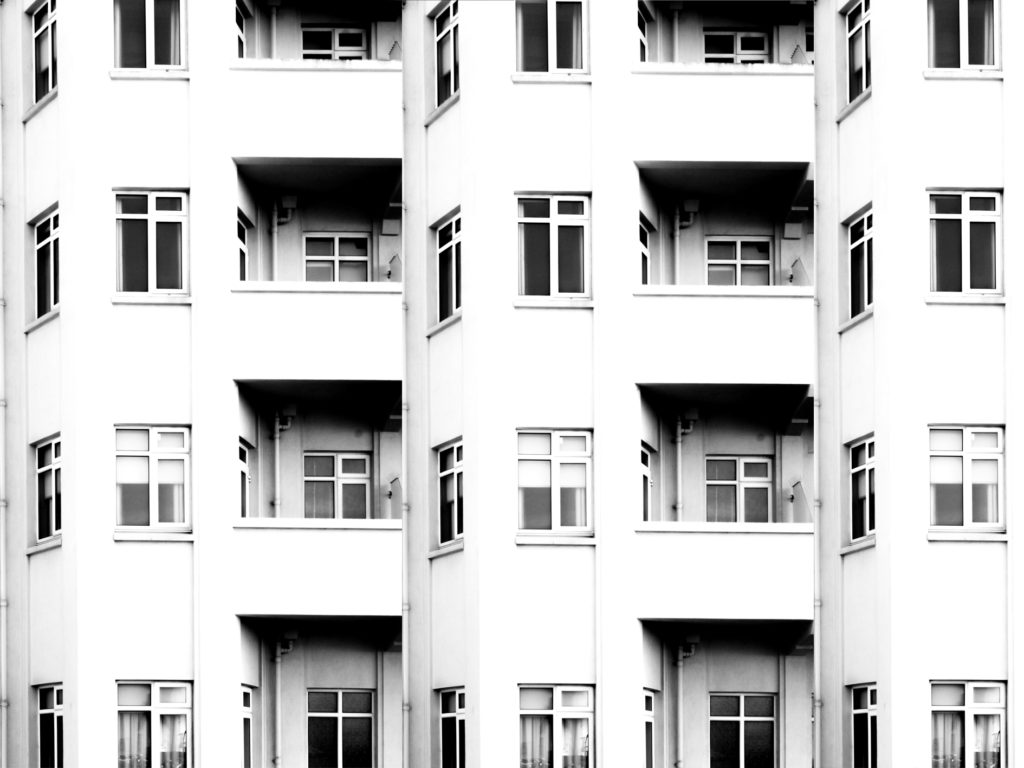
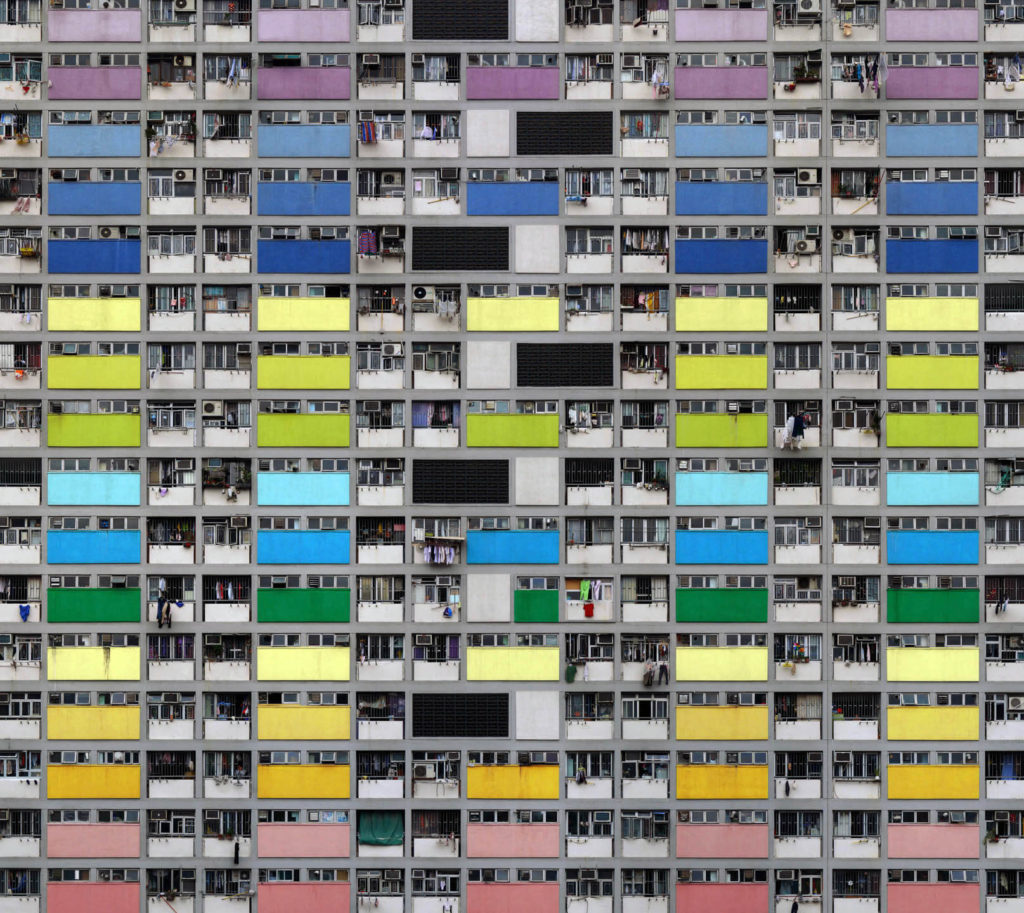
In this photograph from Wolf’s “Architecture of Density” he has used the natural lighting from the city of Hong Kong in order to capture a photograph of a repetitive and colourful high-riser apartment block. By using the natural lighting he has been able to capture the natural tonal ranges and contrasts within the building as well as being able to ensure that the image depicts the city of Hong Kong accurately. A deep depth of field would have been used to capture this photograph of the repetitive apartment block face; this is obvious as all aspects of the photograph are in focus in order to ensure that the viewer can look throughout the photograph and spot the continuing patterns. A fairly quick shutter speed, such as 1/80 will have been used to capture the photograph along with a low ISO of close to 100. This is because Wolf will have altered settings of the camera so that the correct amount of light was entering the lens from the city and that the quality of the photograph was as high and as noise-free as possible. This has led to a photograph that is corrected exposed and is visually pleasing to look at.
There is plenty of colour throughout the photograph due to the colourful panels placed across the apartment block; despite this there is not much saturation in the colours as they seem quite bleak and faded. To me this has been done on purpose by Wolf to suggest that this high-density, repetitive type of apartment block is not a sustainable or enjoyable way of living and represents how the population of Hong Kong feel about their living situation – it all seems quite bleak and boring as there is no room for innovation. There is a good level of contrast between the tones within the photograph as there are plenty of black tones within the shadows of balconies contrasting with the lighter tones of the coloured panels – this contrast increases the drama within the photograph to create a more striking composition. Due to the flat nature of the face of the apartment block there is a very 2D feeling to this photograph, but it does not take away from the effectiveness of the photograph as it further demonstrates the repetition and patterns shown throughout the apartment block.
This photograph is part of Wolf’s “Architecture of Density” in which he photographs Hong Kong’s tall buildings in order to show them as “abstractions, never-ending repetitions of architectural patterns”. The project included books published, including Hong Kong: Front Door/ Back Door which allowed Wolf to present the photographs collectively to prompt the reader to compare the structures, shapes and colours within the different Hong Kong high-risers and therefore demonstrated variance and similarity in his work. As a whole this work shows how over-populated and dense cities such as Hong Kong are and gives an insight into their lifestyle and possibly the bleakness of it. This work also possibly raises questions about what the human population are going to do in the future as human population constantly rises and we run out of space in these large cities. Property prices are inevitably going to rise as this unsustainable approach continues and it is just an amount of time until the demand for housing increases drastically past the supply of housing.
Who is he?
John Baldessari is renowned as a leading Californian Conceptual artist. Painting was important to his early work: when he emerged, in the early 1960s, he was working in a gestural style. But by the end of the decade he had begun to introduce text and pre-existing images, often doing so to create riddles that highlighted some of the unspoken assumptions of contemporary painting – as he once said, “I think when I’m doing art, I’m questioning how to do it.” And in the 1970s he abandoned painting altogether and made in a diverse range of media, though his interests generally centered on the photographic image. Conceptual art has shaped his interest in exploring how photographic images communicate, yet his work has little of the austerity usually associated with that style; instead he works with light humor, and with materials and motifs that also reflect the influence of Pop Art. Baldessari has also been a famously influential teacher. His ideas, and his relaxed and innovative approach to teaching, have made an important impact on many, most notably the so-called Picture Generations, whose blend of Pop and Conceptual art was prominent in the 1980s.
Baldessari first began to move away from gestural painting when he started to work with materials from billboard posters. It prompted him to analyze how these very popular, public means of communication functioned, and it could be argued that his work ever since has done the same. He invariably works with pre-existing images, often arranging them in such a way as to suggest a narrative, yet the various means he employs to distort them – from cropping the images, to collaging them with unrelated images, to blocking out faces and objects with colored dots – all force us to ask how and what the image is communicating.A crucial development in Baldessari’s work was the introduction of text to his paintings. It marked, for him, the realization that images and texts behave in similar ways – both using codes to convey their messages. Text began to disappear from his work in the early 1970s, and since then he has generally relied on collage, but his work has continued to operate with the same understanding of the coded character of images.
Typically, he collages together apparently unrelated categories of image or motif, yet the result is to force us to recognize that those images often communicate similar messages.On a visit to the Metropolitan Museum in New York in 1965, Baldessari was struck by the use of unpainted plaster to fill in missing shards of Greek vases. This prompted his interest in how images are effected by having portions removed or blotted out, and he has continued to explore this ever since. Often, the result of his alterations to photographs is to render them generic, suggesting to us that rather than capturing a special moment, or unusual event, photographs often communicate very standardized messages. Here are some examples of his works:
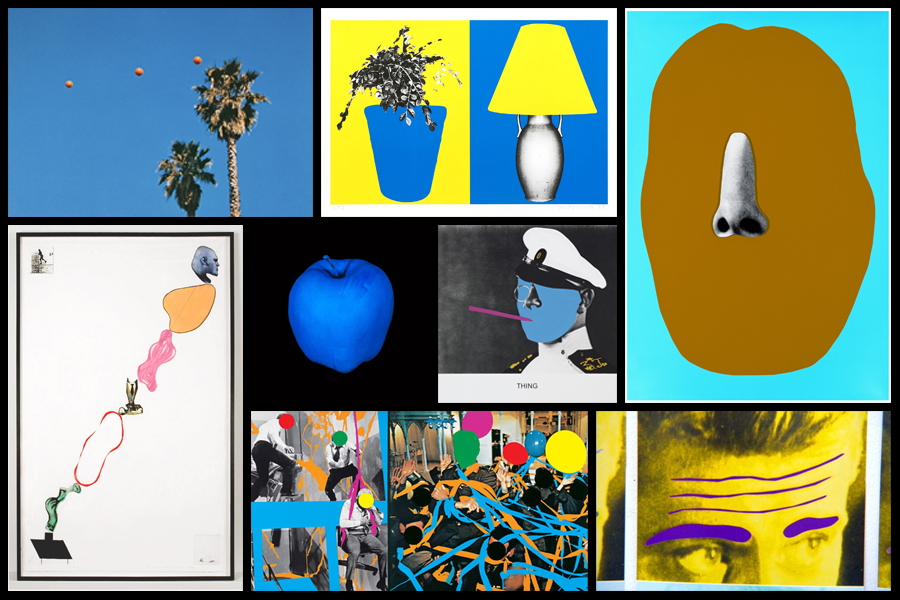
After looking over some of his work I decided to create a response to the project he worked on called Throwing Three Balls in the Air to Get a Straight Line. This project attracted me because of how bizarre and unique it was, using the formation of randomized ball positions in the air to create ‘art’. I then proceeded to make a response to this by throwing various balls in the air and attempting to capture them mid-flight, using only the backdrop as the main form of contrast in the photo. I would also experiment with shutter speed where I would try to capture other moving subjects, here were my results:

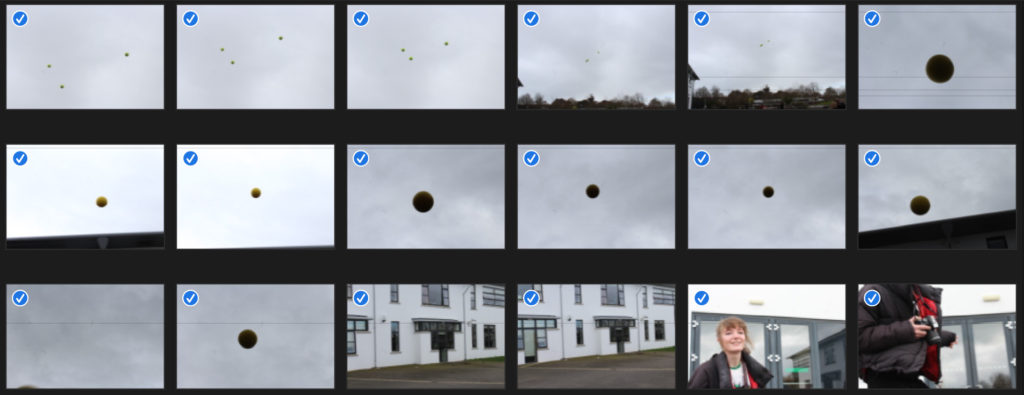

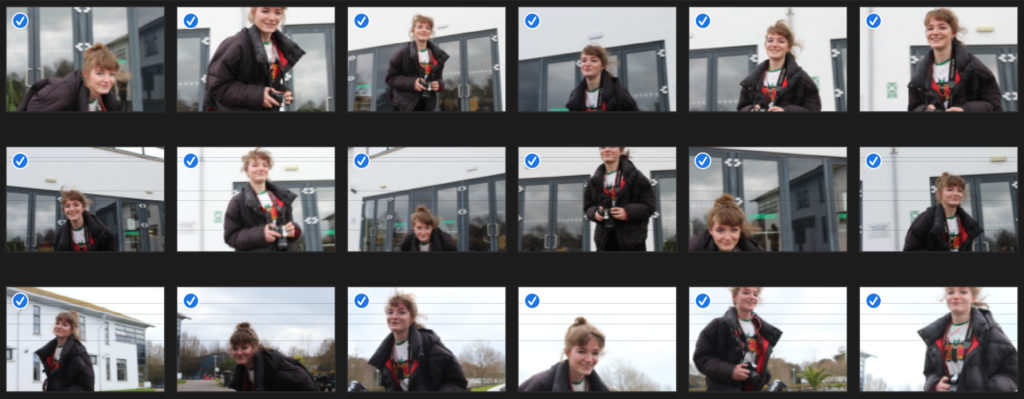
Once I had completed this task I decided to pick out the three images that I thought best reflected what I wanted to experiment with, here were the results:
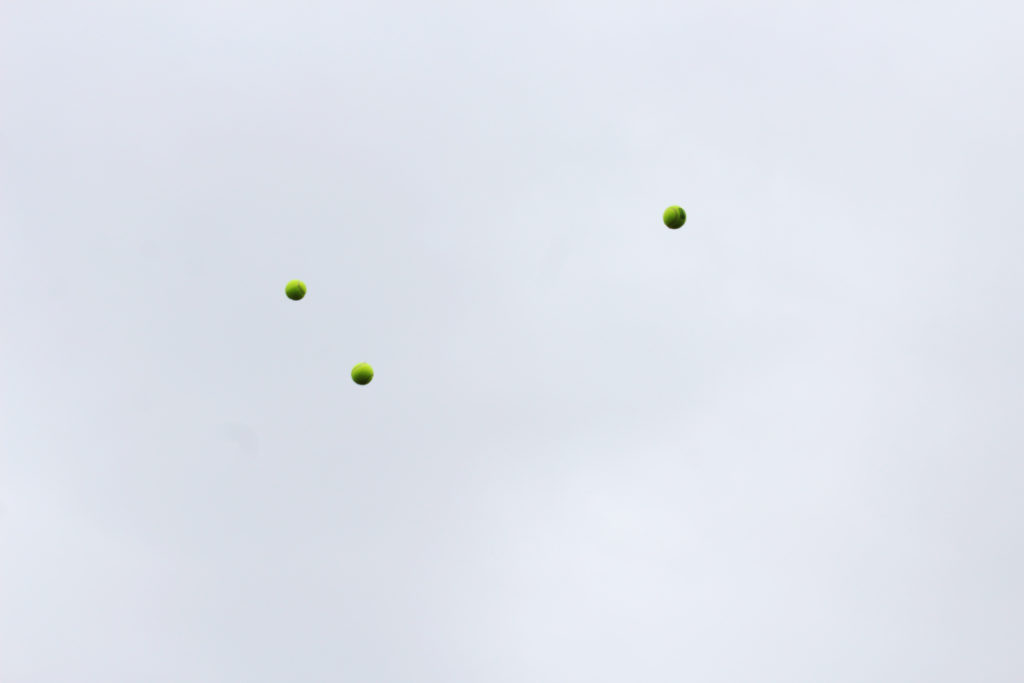
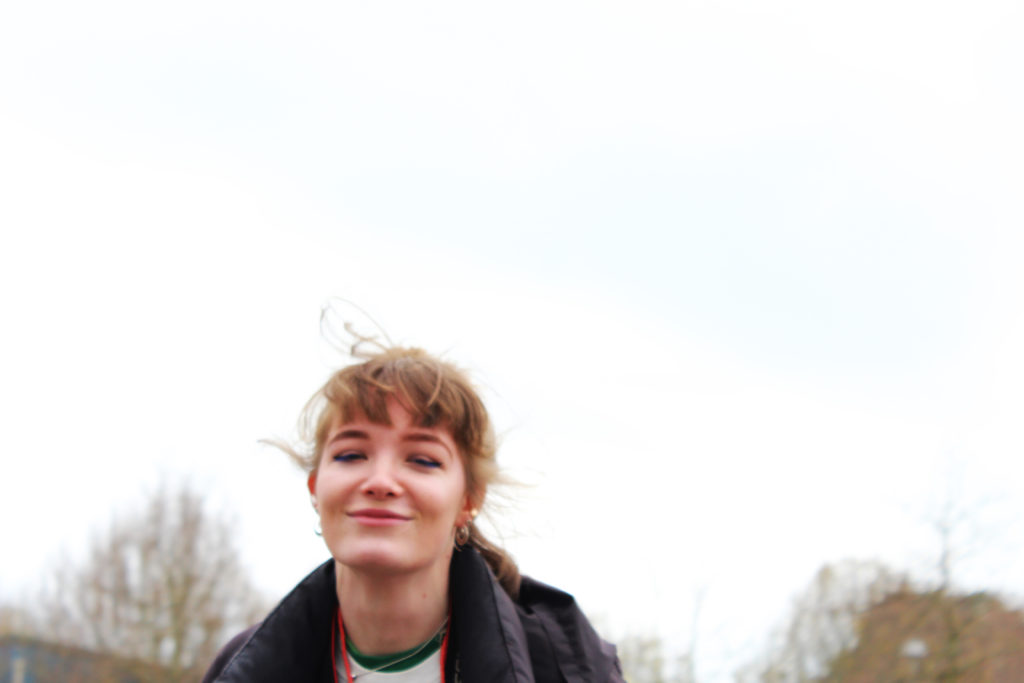

I really liked the idea of capturing a subject mid movement as it allowed for a new stance of photography I had not previously explored. In future shoots I could look at things like birds mid-flight or people and shadows, this would open up opportunities for further abstraction of the environment photographed as by incorporating moving things it could bring the image into life.
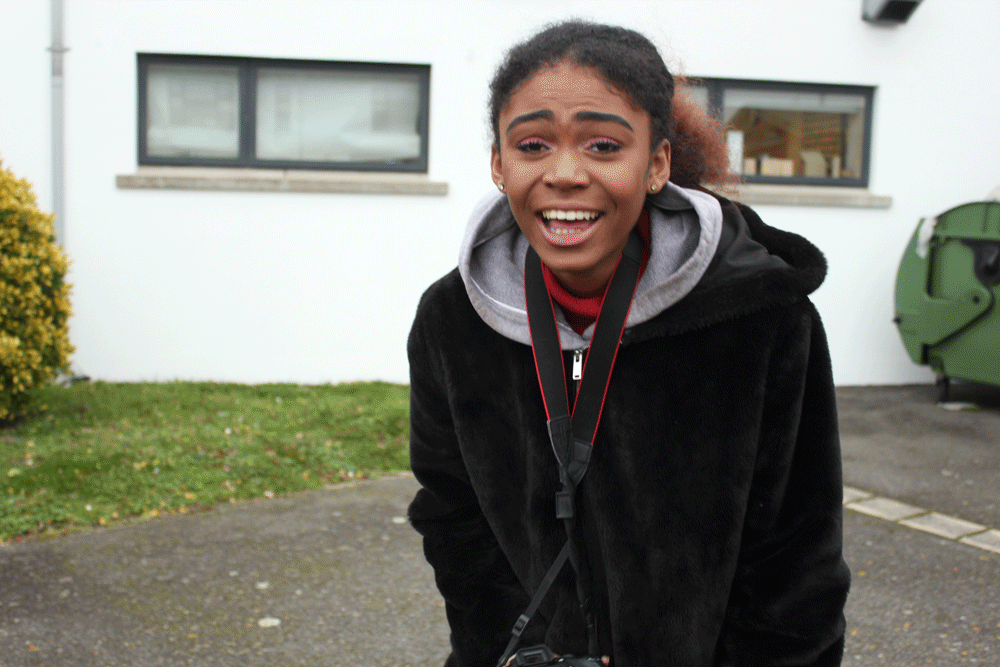
I was inspired by John Baldessari to capture images of a model moving and dodging the camera, due to his photographic art being humorous, so I experimented with something that I could create into a style similar to his. I wanted my model to appear as if she is boxing, hence why she is clenching her hands into a ball to appear as if she has boxing gloves on. On my camera, I used the setting Tv, put the white balance to cloudy (approx 6000K on my camera), and set the ISO to 1/200 for this first shoot. This made my images quite sharp and clear, due to a fast shutter speed.
For this experiment, I changed my camera settings; I kept the white balance and camera setting ‘Tv’ the same, however I lowered the ISO to 1/160. I told my model to do the same technique and movements as the last shoot, where she had to try and run around and dodge to camera. I decided to make a grid layout as I felt that this repetition of similar images is easy and interesting to look at from this sort of format.
To make this grid layout, I used photoshop. My first step was to create a square canvas. Next, I went to view, new guides and clicked horizontal 450px. I did this again but changed the px to 900px. Then I repeated this for vertical guides, where I chose 450px and then did it again with the vertical option selected and put 900px.
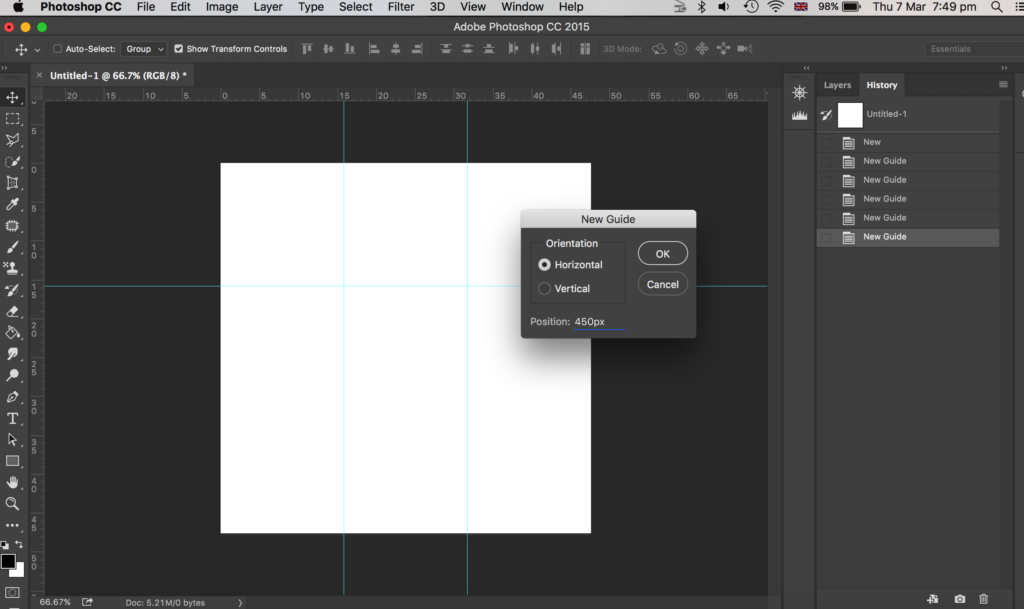
Then I went to view and chose lock guides.
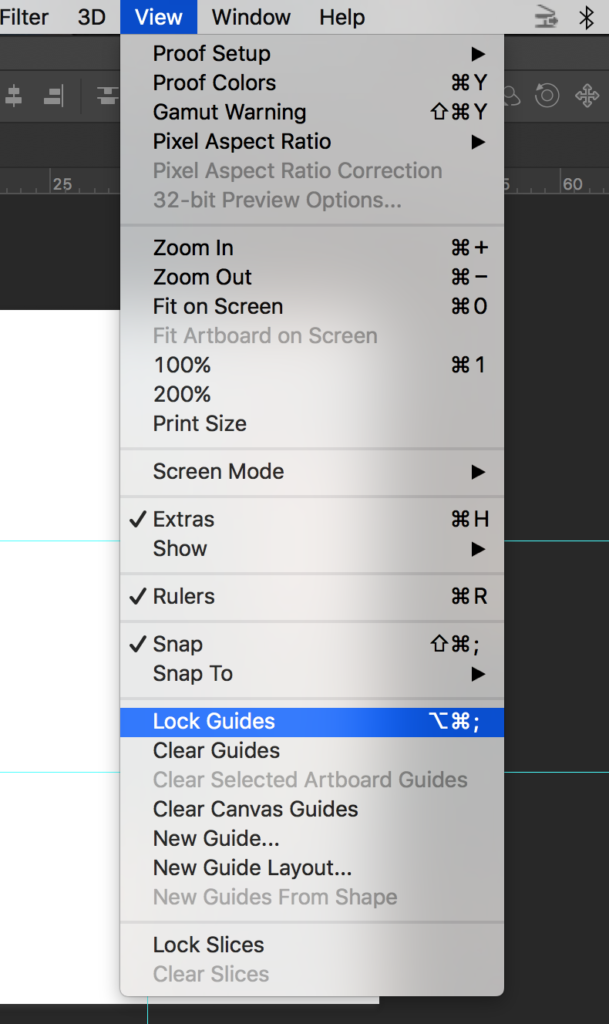
Then I opened up all my images on photoshop that I wanted to use – I chose 9 images of my model dodging the camera. I went onto each photo in photoshop and went to select, all and edit, copy.

Then I went onto the canvas I made with guides and went to edit, paste. To make my image smaller to fit on the canvas I went to edit, free transform where I could then adjust my image size. I placed it within one of the squares the guides had made. I then got the rectangular marquee tool and made a selection of what part of the image I wanted to get rid of; I wanted the image to be square, with a white border in between the image and the guidelines. Then I went to layer, layer via copy.
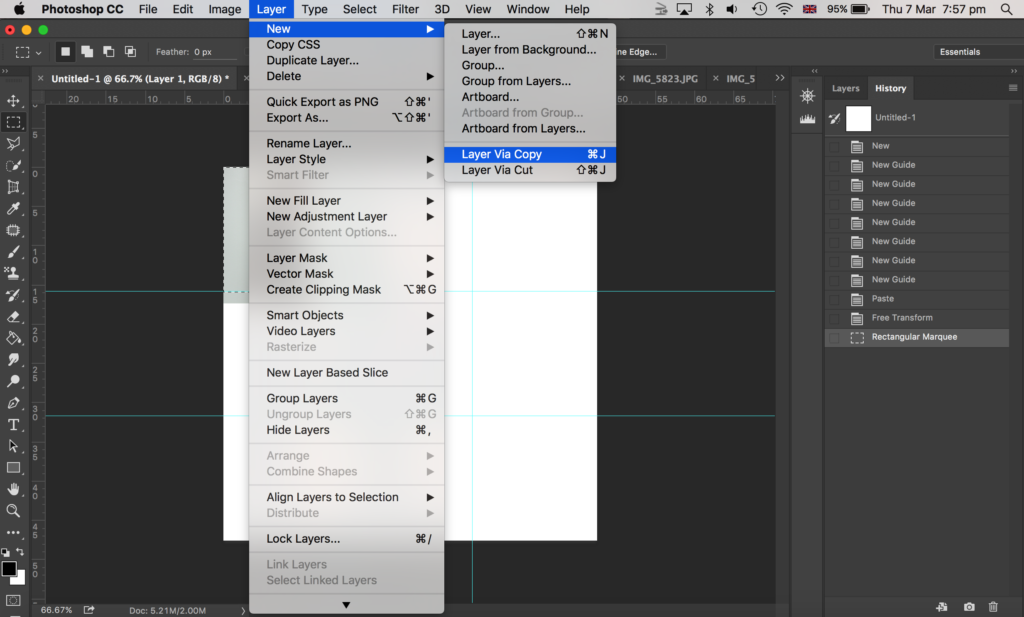
After that, I went onto the layers panel to the right side of the image shown above, and deleted the original layer of that image (before I cropped it) so that I was left with a cropped version of that photo which I made as a square shape.
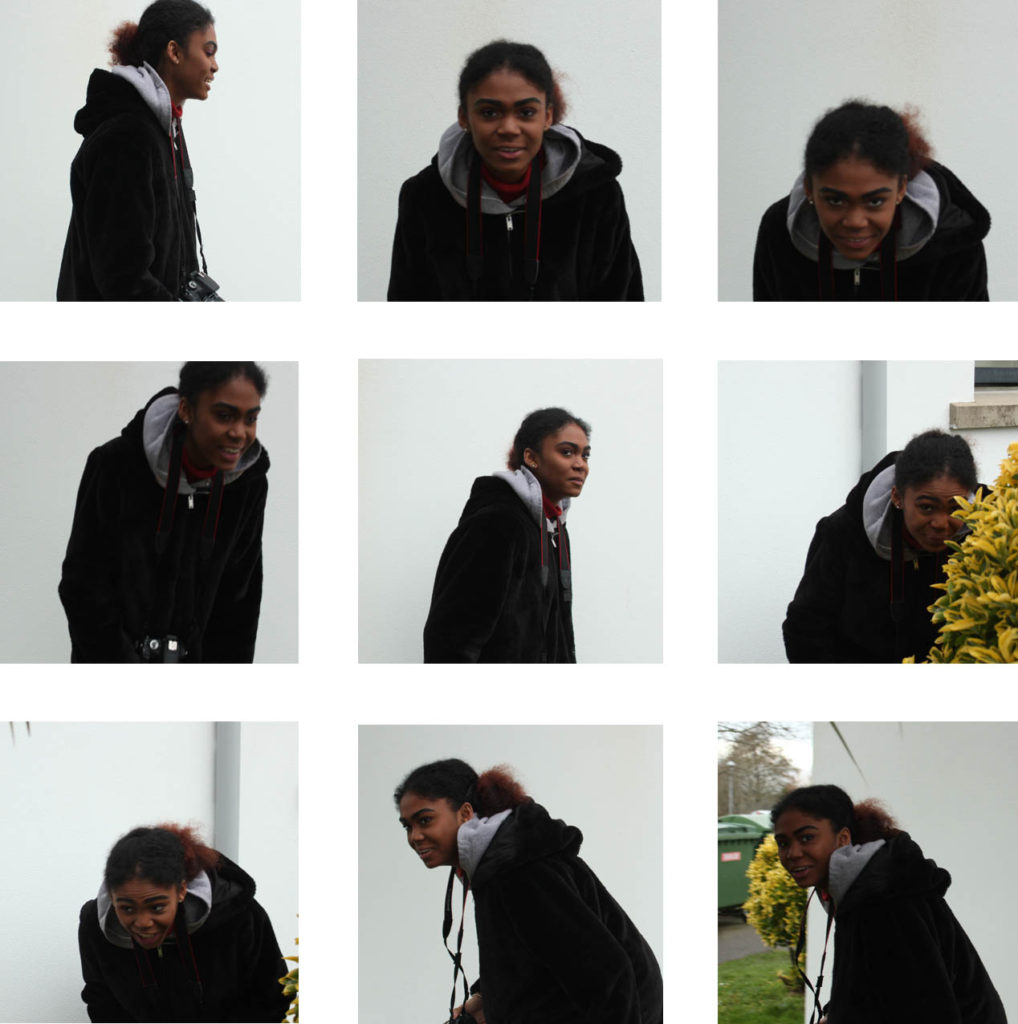
Here is my final outcome as shown above.
I did the same game of play, where the model had to run round and dodge the camera and make actions as if she was boxing, yet I wanted to experiment with the ISO again. So, for this experiment, I lowered the ISO to 1/100. This made the images blurrier due to a slower shutter speed.

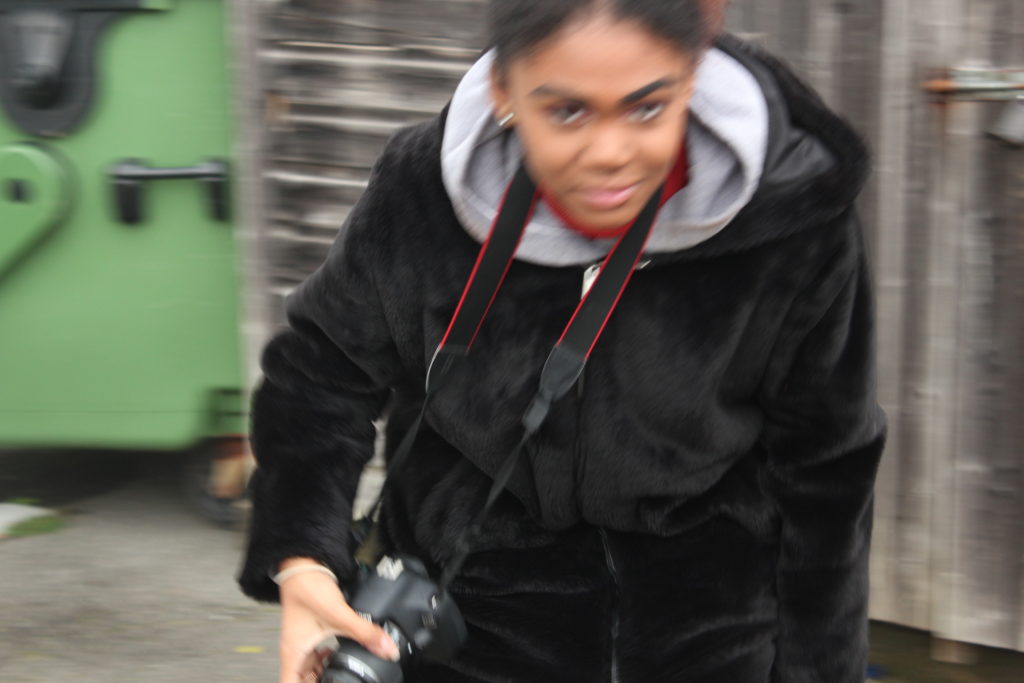

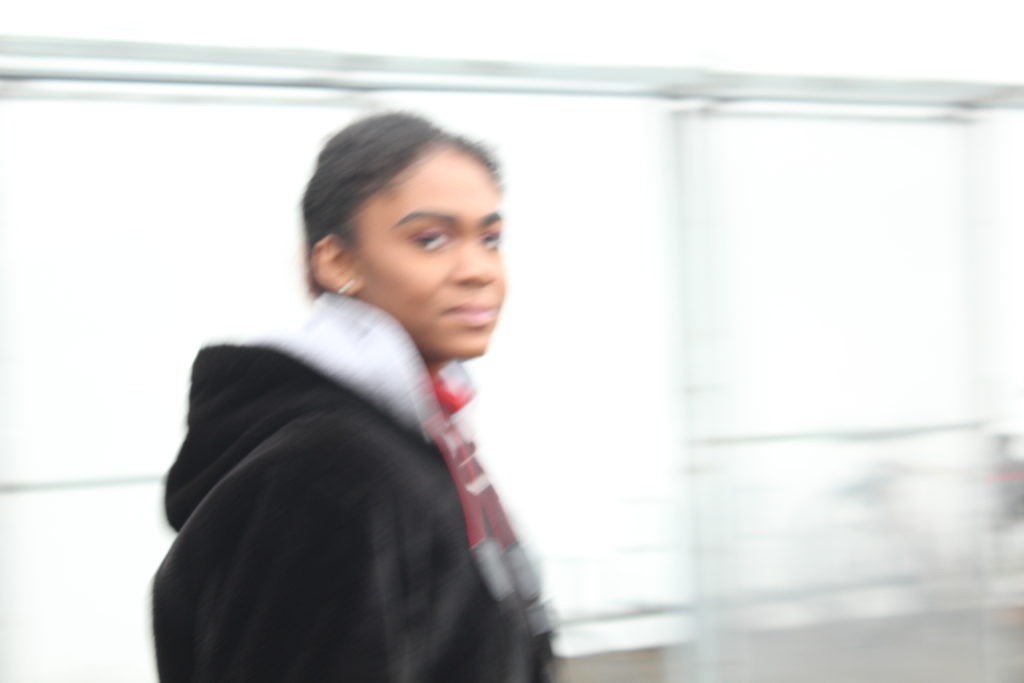
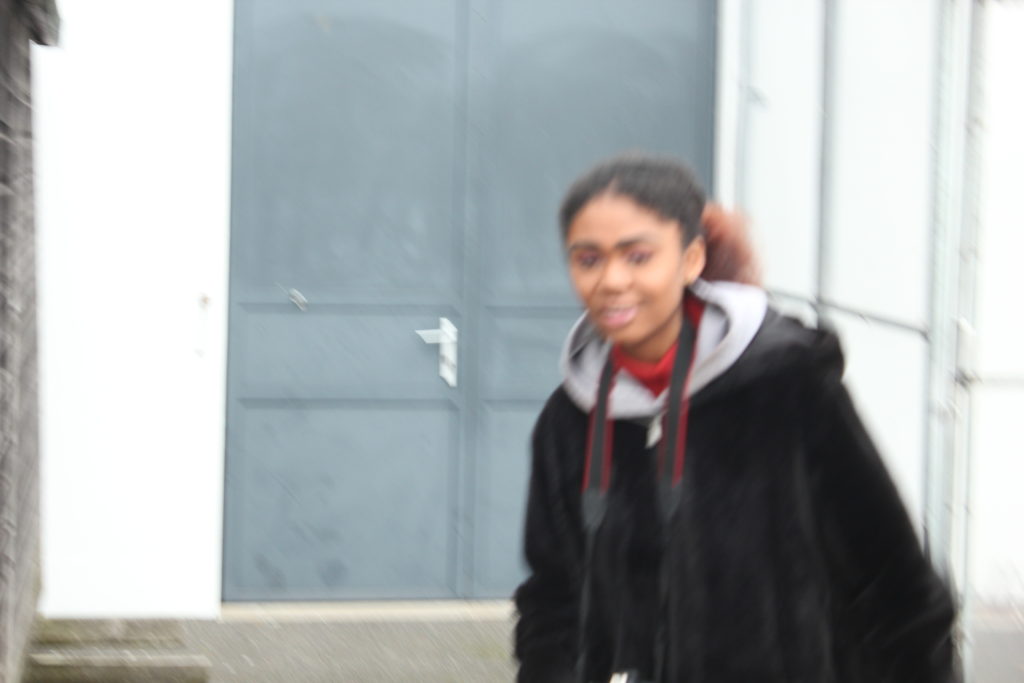
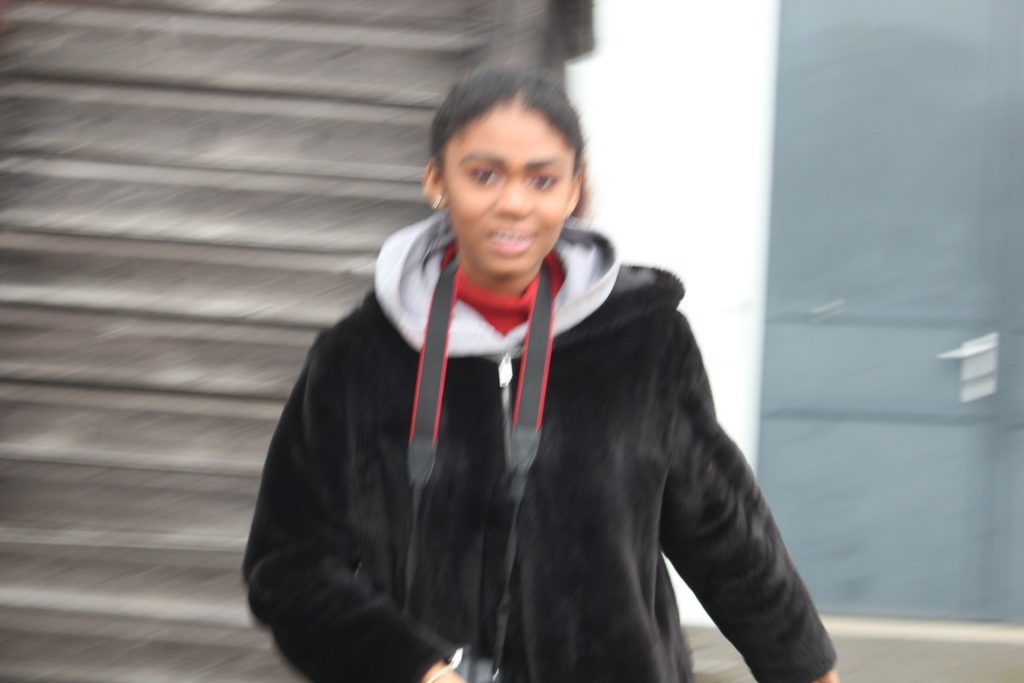
Overall contact sheet of my first ‘play’ shoot:
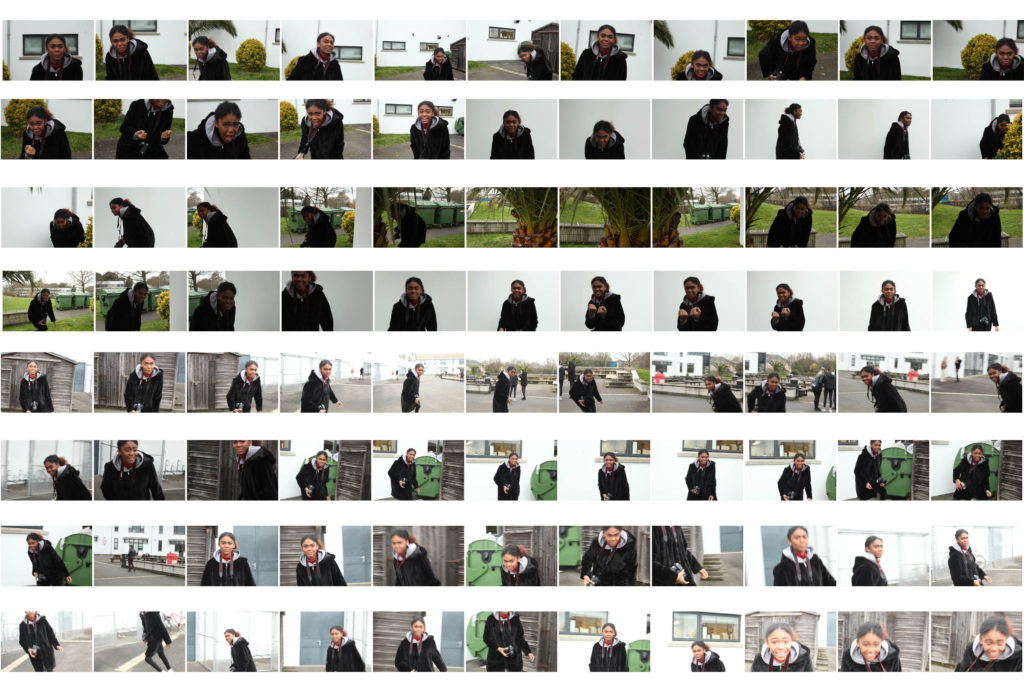



For this experiment, I got my model to throw up one yellow ball in the air. This was an idea inspired by Baldessari, again, as he throw oranges up into a clear sky in California. However, because the sky was cloudy and grey (unlike Baldessari’s blue sky,) I chose a yellow ball to throw into the air as I felt this would be a clearer colour to see in the dark, gloomy sky. I experimented with the ISO; the first image is with an ISO of 1/200, which made my image appear lighter. The other 2 images are where I experimented with a lower ISO so they appeared darker.
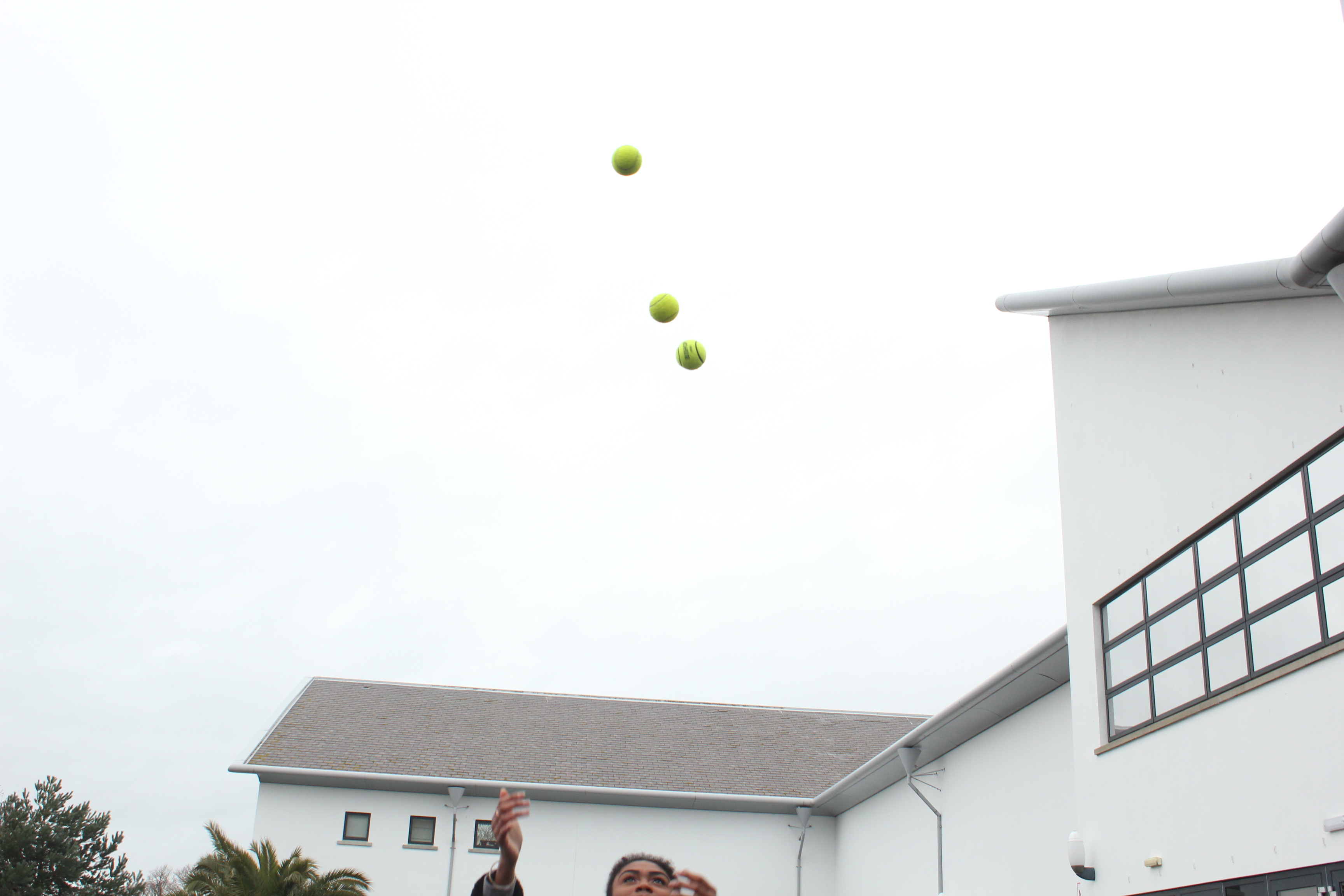

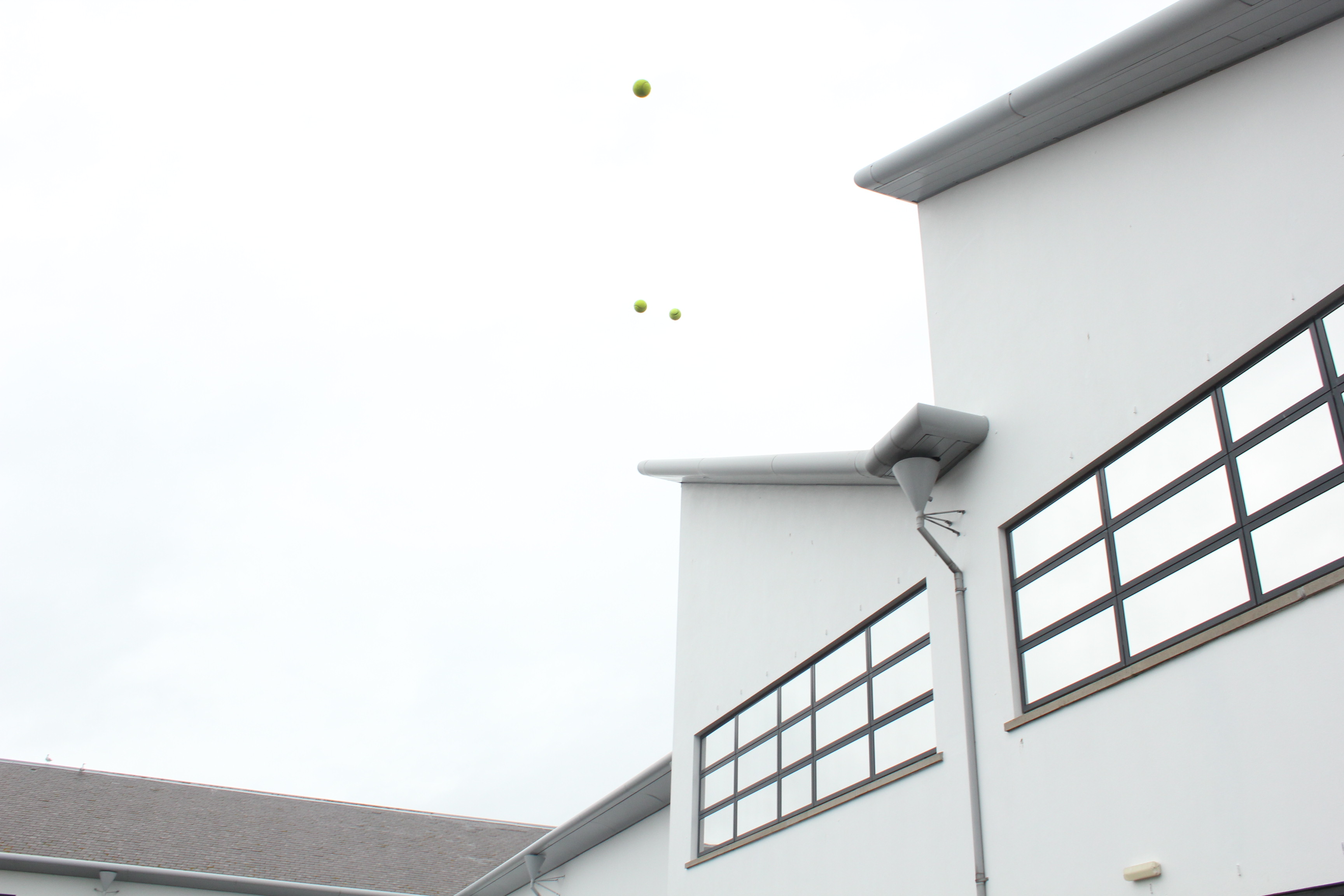

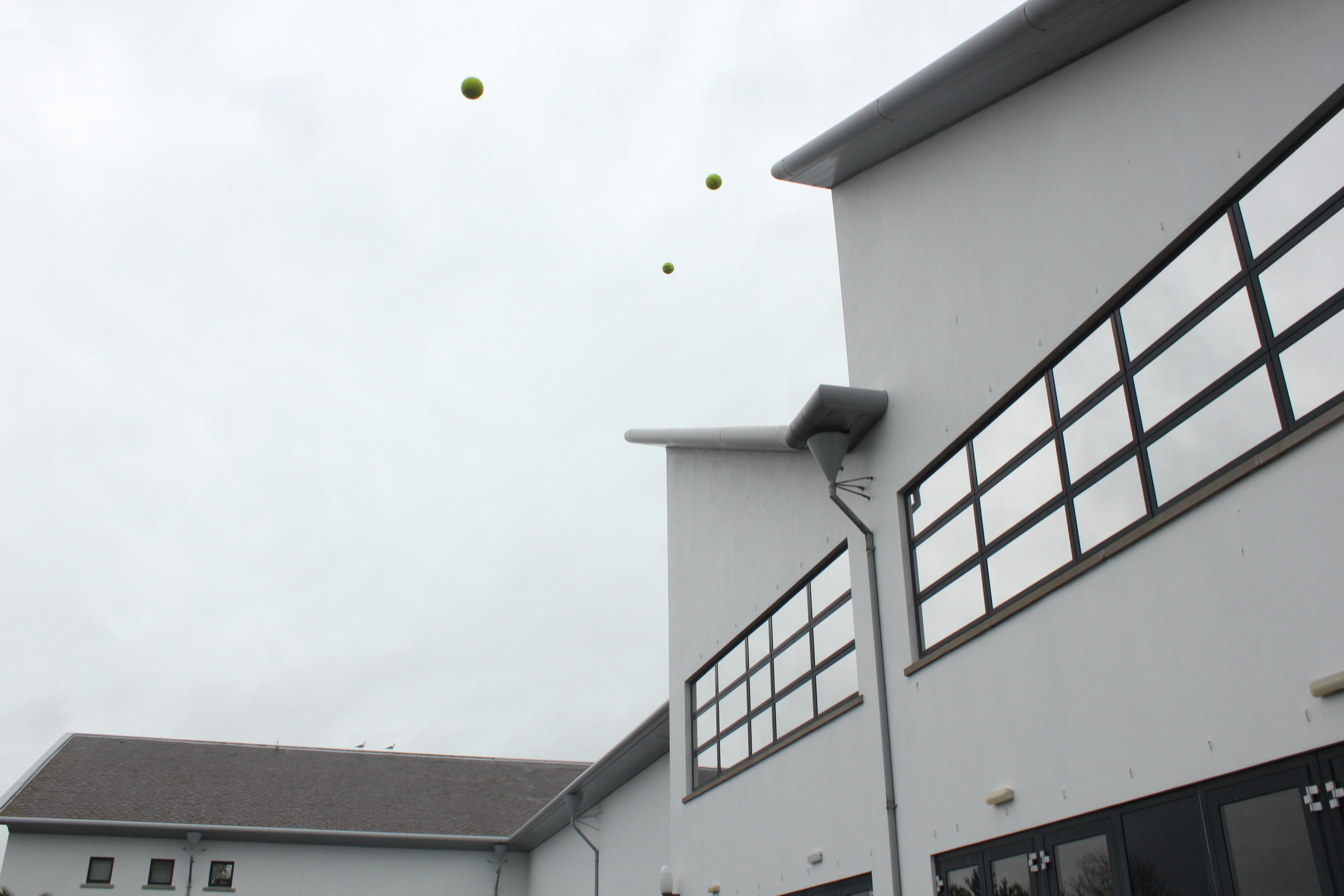

With this experiment, I then used 3 yellow balls and got my model to throw them up into the air, again, like Baldessari’s work of throwing oranges into the sky. To achieve a similar image to his, I got my model to throw all 3 balls at the same time, so that it created a line of the 3 balls.
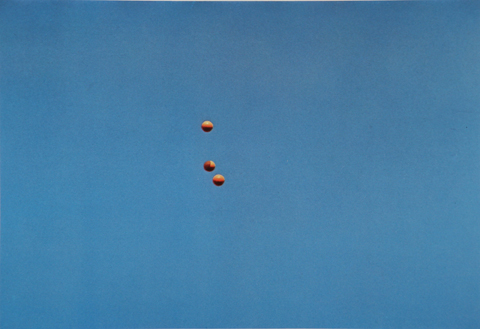

John Baldessari was a leading Californian conceptual artist. Painting was important to his early work, but by the end of the decade he had begun to introduce text and pre-existing images to create riddles that highlighted some of the unspoken assumptions of contemporary painting. In the 1970’s, he abandoned his interest in painting and began to make a diverse range of media, though his interests were based on the photographic image. Conceptual art has shaped his interest in exploring how photographic images communicate. However, he works with light humor and materials and motifs that reflect the influence of pop art. He works with pre-existing images, arranging them in a way to suggest a narrative. He seems to distort his images – from cropping the images, to collaging them with unrelated images, to blocking out faces and objects with colored dots; this all forces us to ask how and what the image is communicating.

The image above is part of Baldessari’s approach to conceptual art during the 1970’s. This photo is of 6 people who seem to be dressed smart and professional. The image portrays normality, as it is a simple image of 5 men and 1 women that are staring out the window. Baldessari liked to incorporate into various features into his work, such as leaving us with questions about what the image is communicating and showing or trying to tell us. This aspect of the photo, where all the models seem to all be bunched near the slanted window creates this sense of uncertainty and leaves us wondering what are they all so attached on looking at? What is so interesting about what they can possibly see out the window? Additionally, Baldessari was interested in using parts of pop art in his work, as well as collaging his images with unrelated art or other images to block out objects or faces (as he has done in the image above). He has made these models faces invisible – so we don’t know what they look like, what their facial expressions are displaying, if they are talking with each other or where they are looking. Instead, he has used coloured dots to cover their faces which is similar to aspects of pop art, such as artists like Roy Lichtenstein and Andy Warhol., who use small coloured dots to make up their images. Again, this makes the us as an audience of his work, consider all these different factors that he his hiding from us. This is what makes his art and photographic images so intriguing, and why I was influenced to do something on a similar level to Baldessari.
The idea behind this shoot is to explore the different items that people regularly carry around in their school backpack in order to look at the similarities and differences between the contents as well as giving a slight insight into who the person is and what their interests are. Some of the bags that I took photographs of contained only the minimal indicating that the person may be very organised or may not like to carry much on them whereas other bags had lots of random items in them which may suggest they like to ensure they have what they could possibly need throughout the week on them at all times and may not mind having clutter in their bag. This shoot relates to ‘Variance and Similarities’ as it can show how one standard thing that everyone does/has can vary so widely but then at the same time they will all have similar items within the bags, such as pencil cases or lined paper. The shoot takes inspiration from Huang Qingjun’s ‘Jiading’ meaning ‘Family Stuff’ and shows an insight into the unlimited variety of combinations of different belongings that people may carry around with them.
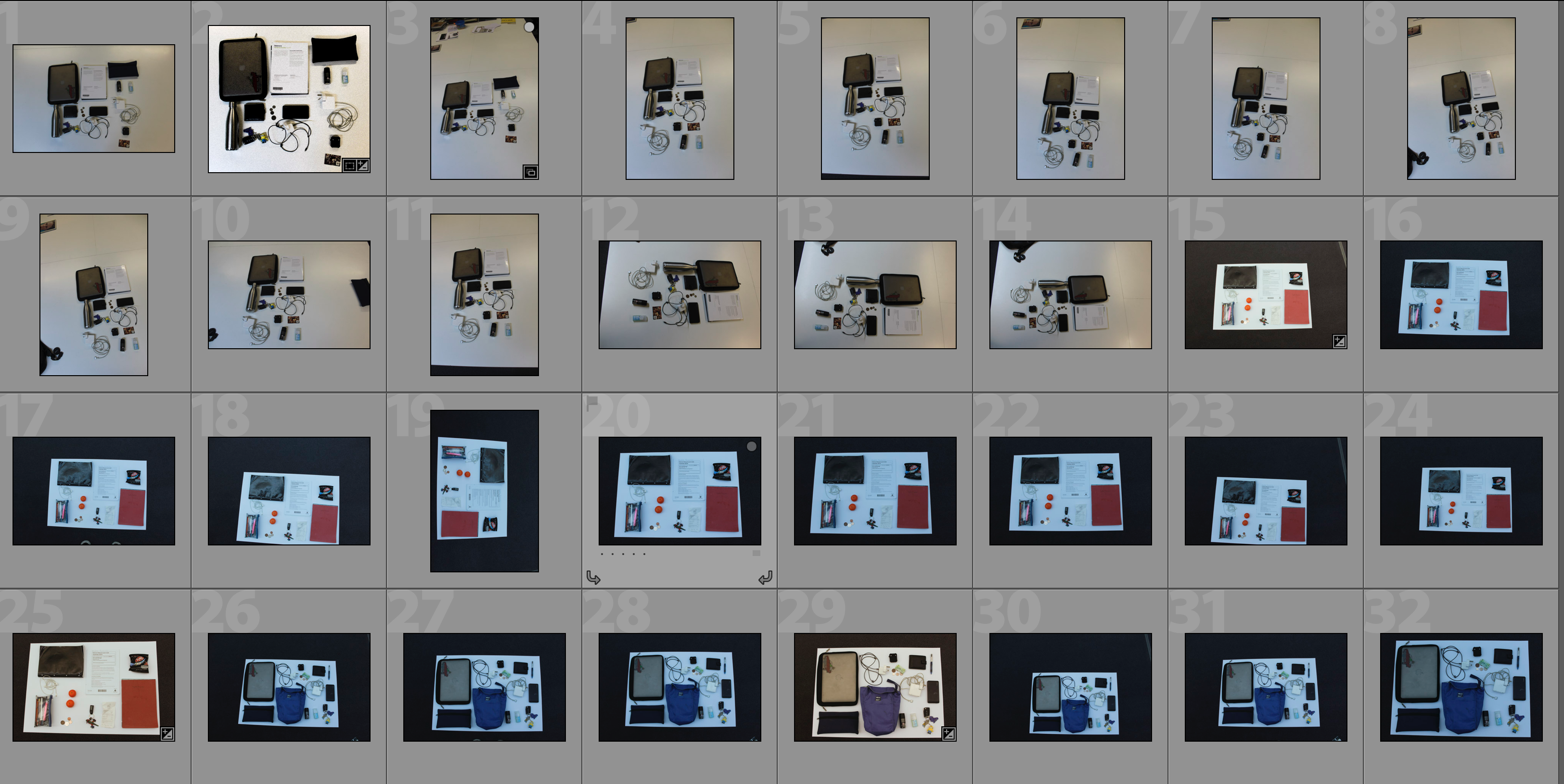


In order to capture the photographs I would empty out the bags onto a blank sheet of white paper and arrange the items into a displayable arrangement with slight separation between each item in order to allow each item to be observed individually. A would then photograph all contents from the same height facing the camera directly towards the floor. I edited the photographs to create the outcome achieved by first editing the distortion of the picture and the perspective so that the photograph would be face-on to the camera and then I would crop it so that only the white background can be seen. I then changed small features such as white balance, exposure and contrast to create a more visually aesthetic composition. The idea behind the editing was that each photograph would have the same setup to allow the features to be compared side-by-side.

Below I have experimented with presenting my outcome in the form of a GIF. The first GIF shows each frame for 0.2 seconds whereas the second GIF shows each frame for 0.5 seconds. I have included both speed of GIF’s as I feel that they present the photographs in different ways – the faster GIF creates a more abstract approach where the viewer has to concentrate closely to pick apart the individual photographs whereas the faster GIF’s allow the viewer to focus more on each individual photograph and to compare the photograph’s features more. The use of a GIF allows for quick comparison of the photographs in an interesting way and suggests how different each picture is even though they have a different layout because the first thing the viewer notices is shapes and colours and then they have to look closer to understand what the photograph is showing them.
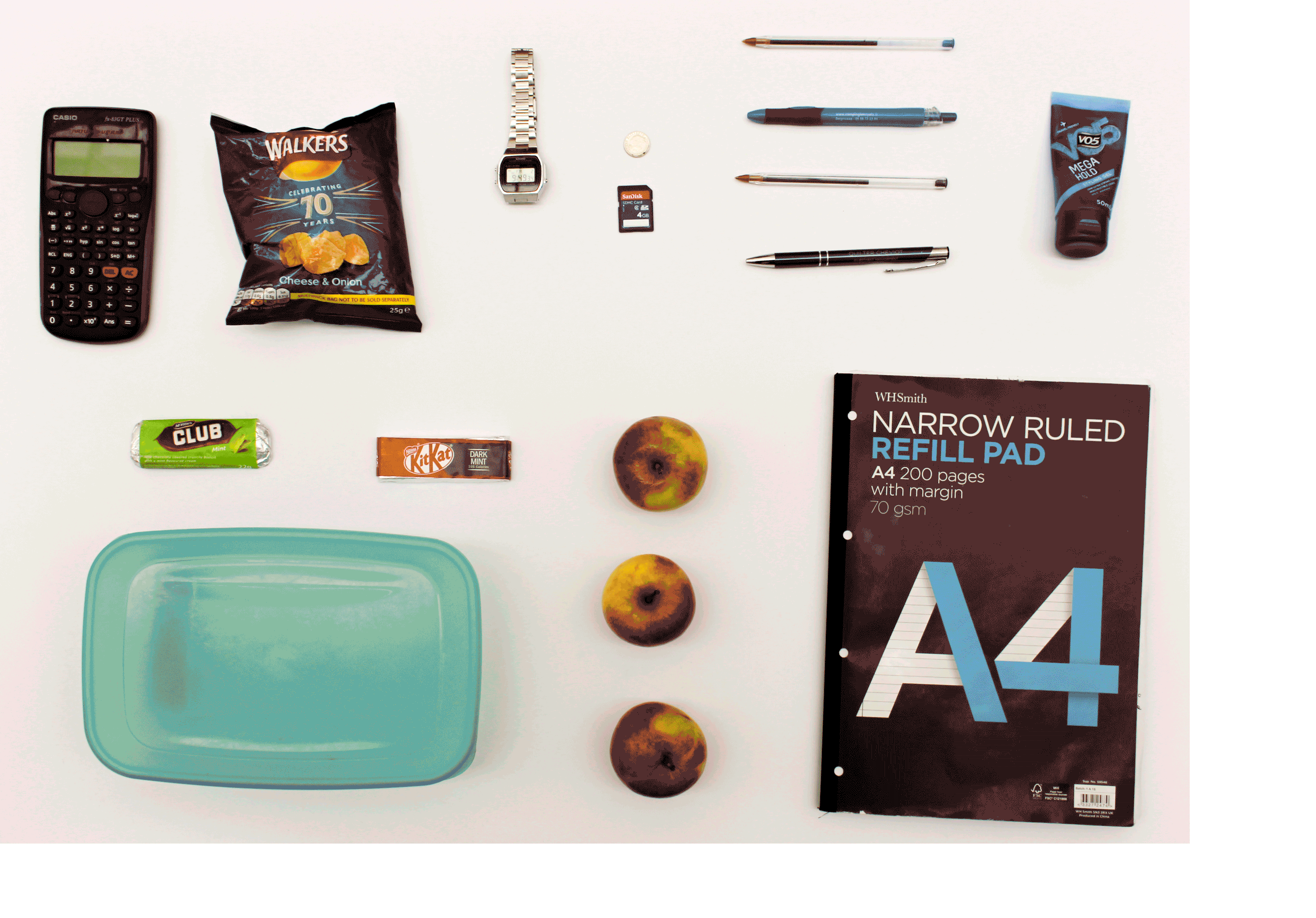

In this photograph I have used the natural lighting from the roof windows in order to ensure that a consistent light is spread across all of the items within the photograph. The skylight also allows for the light to shine directly down onto the items from the bag and so reduce the shadows within the photograph to emphasise the difference between each item and the shapes within them. Due to using a sharp white sheet as the background for this photograph there is a clear contrast between the items, such as the apples, and the background. This has also allowed for the tones within the photograph to be more clearly defined. I used a deep depth of field to capture this photograph as I wanted to ensure that all of the items featured in the photograph were clear and sharp because each item featured gives an insight into the personality and life of the person to which the items belong. I used a shutter speed of 1/60 when taking this photograph as well as an ISO of 100. The low ISO ensured that the noise within the photograph was kept to a minimal and that the photograph was as of high quality as possible – the 1/60 shutter speed paired with this to ensure that there was enough light entering the lens from the surrounding environment and that the photograph was correctly exposed. There is a slightly warm colour cast to the photograph which reflects the fact that this shows items which everyone is familiar with, and so creating a warm feeling.
This photograph contains a wide variety of colours due to the fact that there are varying items that use different colour schemes to appeal to their target market, such as chocolate bars using colourful packaging and note pads using more subtle grey tones. Using the white background to place the objects on has allowed the shapes of the items to be clearly defined as well as the textures within them – the shininess of the crisp packet and its creases can be seen for example. There is also a slight 3D effect due to this reason and slight shadowing – this helps to emphasise the individual features of each object. The objects have not been set out in any specific way or pattern; they were set out in a way that displays each of the objects individually therefore the layout is quite random and forces the writer to focus on each subject rather than as a collective.
The idea for this shoot comes from Huang Qingjun’s ‘Family Stuff’ project in which he would photograph the rural residents of China outside of their houses along with all of their personal possessions. My work on this shoot links to this work by Qingjun as these contents of an individuals bags give an insight into who the owner of the bag is, in the same way as the possessions of the Chinese residents gave an insight into the way in which those people lived. When the photographs in this shoot are paired together it creates comparison between the different contents of bags to show both variance and similarity between people and the objects that they tend to carry around with them in a school bag. The variety of items that are carried in each bag show whether the person likes to carry either the minimum with them or carry clutter, as well as often showing an insight into their diet. Small details such as these start to paint a bigger picture of who these people are.


DEFINITION = Conceptual art is art where the idea (or concept) behind the work is more important than the finished art product/object.
It emerged as an art movement in the 1960s and the term usually refers to art made from the mid-1960s to the mid-1970s. When an artist uses a conceptual form of art, it means that all of the planning and decisions are made beforehand and this has greater importance that the artists final outcomes. Conceptual art can be anything – the overall visual aspects of conceptual art may be confusing, misleading or it could be boring or interesting. The reason that it became an art movement is because of its intriguing features – many people look at conceptual art and wonder why an artist has displayed something in this form. There are many artists that had made conceptual art, but it was only defined as a distinct movement in an article written by Sol LeWitt in 1967. The link attached shows many of the artists that have formed conceptual art, and many of their exhibitions. Some of these are Bruce Nauman, Martin Creed, John Baldessari and Bernd Becher and Hilla Becher. They all take approaches to this that have influenced many other artists and artworks. For example, Bernd and Hilla Becher focus their work on typologies.
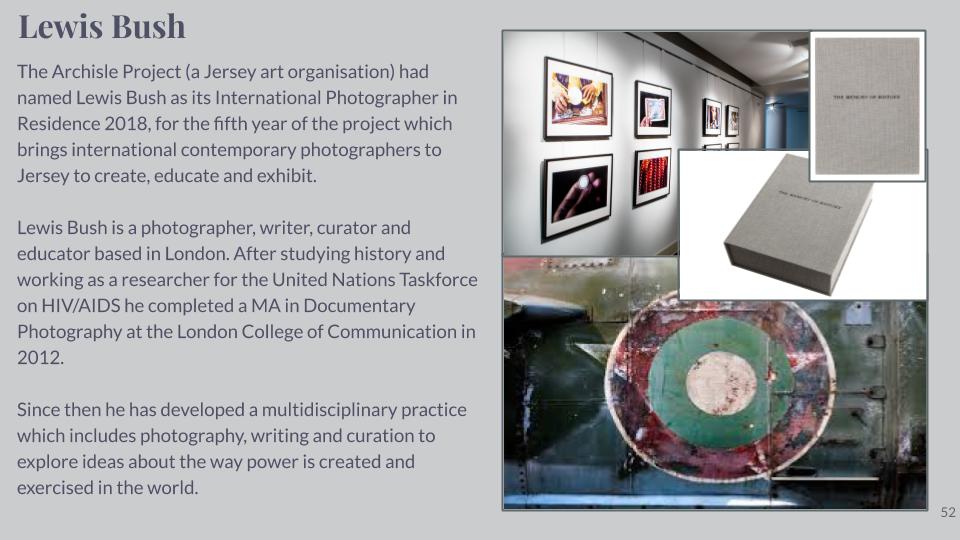
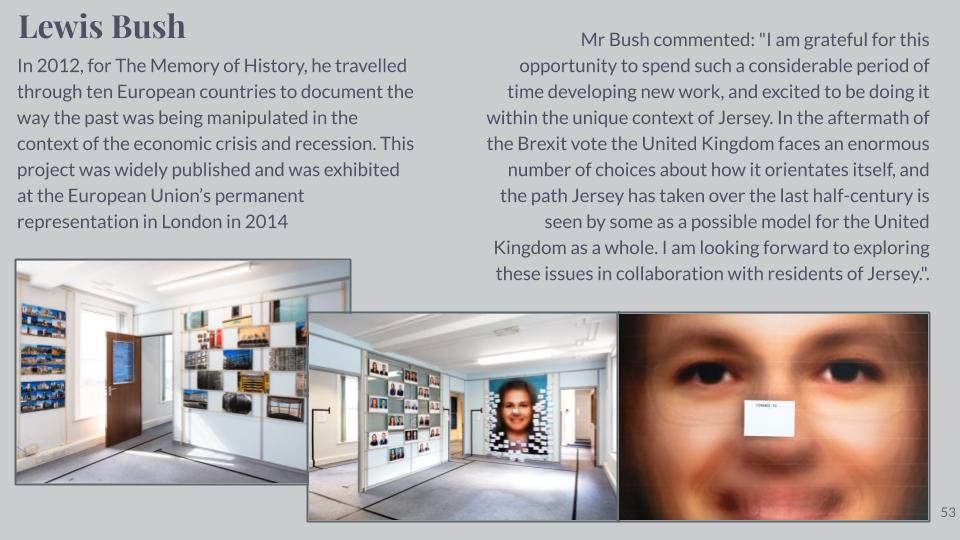
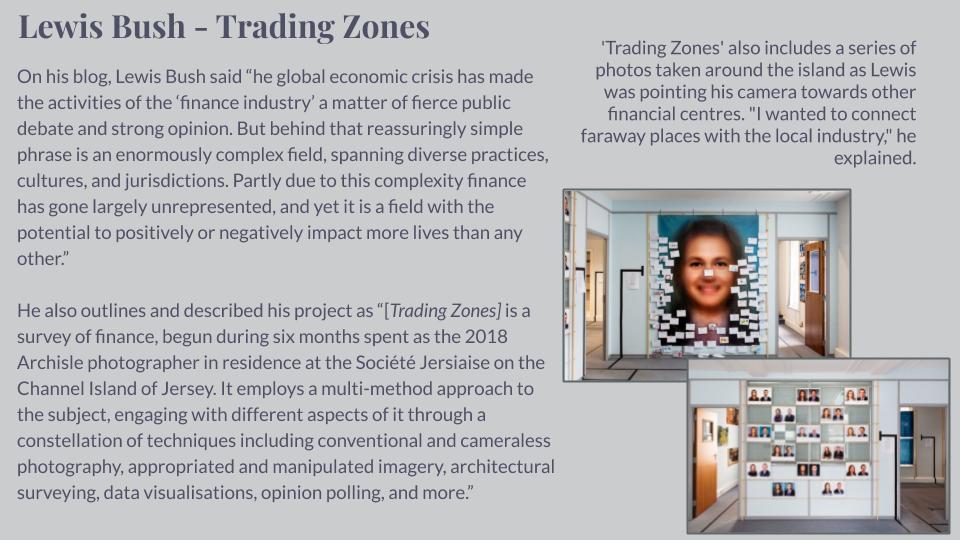
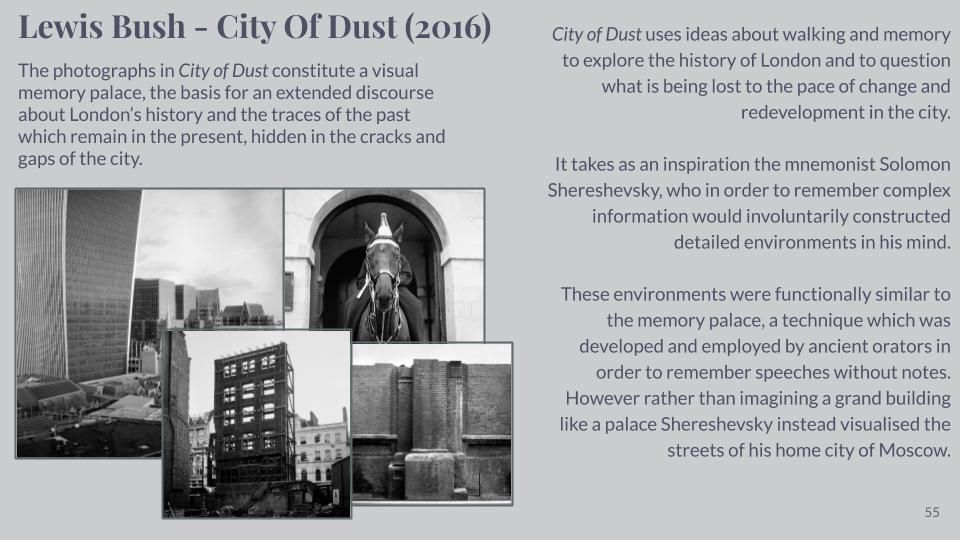
sources: